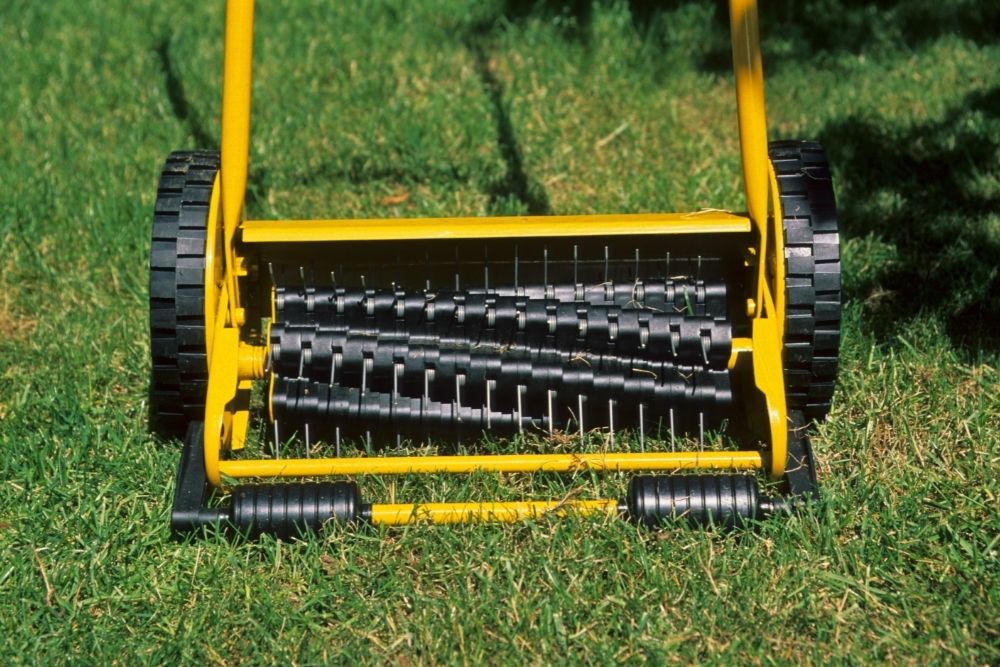As an important part of lawn care, a scarifier is used to get rid of thatch and encourage new grass growth. But what does scarifying really mean, and when should you use one? This guide tells you everything you need to know about scarifiers to keep your lawn healthy.
What is Scarifying?
Scarifying refers to the process of tearing up the lawn surface to remove excess thatch Thatch is a tight, mat-like layer of dead grass stems, fallen leaves, and debris that builds up between the grass blades and soil over time
While a thin layer of thatch is normal too much prevents water air, and nutrients from reaching the roots. It also harbors fungi, pests, and diseases. Scarifying rips through this thatch barrier with mechanical blades to restore proper lawn function.
Why Scarify Your Lawn?
- Removes thick thatch to improve moisture and nutrient absorption
- Pulls up dead material and stubborn moss
- Loosens and aerates compacted soil
- Allows more sunlight to reach the grass base
- Reduces fungal diseases and pest problems
- Stimulates stronger grass growth
- Improves lawn appearance
When to Use a Scarifier
Timing is crucial for effective scarifying. The best times are:
-
Spring – Between early March and late May when cool-season grasses break dormancy. Allows recovery before summer stress.
-
Early Fall – August to early September suits warm-season grasses like bermuda before winter dormancy.
-
Avoid summer heat and drought when grass is stressed.
-
Scarify at least once a year for health; 2-3 times is better.
How to Scarify Your Lawn
Follow these steps to scarify properly:
-
Mow the lawn short so blades access the thatch layer.
-
Adjust scarifier tines to the desired depth setting – shallow for light thatch removal or deeper to disrupt soil.
-
Either walk behind a manual scarifier or use a powered one to make overlapping passes across the lawn.
-
Rake up the pulled-up debris and remove it.
-
Top dress bare patches with fresh soil or compost if needed.
-
Allow 2-3 weeks of recovery before mowing again.
Manual vs Power Scarifiers
Manual scarifiers are hand tools dragged across small areas. They mainly lift light thatch.
Power scarifiers use motors to rotate blades faster and deeper for large lawns. Tow-behind models attach to riding mowers.
Lawn Scarifying Tips
-
Scarify in different directions for complete coverage.
-
Remove only 1/3 of the turf at once to prevent damage.
-
Apply nitrogen fertilizer after to stimulate growth.
-
Overseed thin areas with suitable grass seed.
-
Water thoroughly after scarifying.
Maintain a Healthy Lawn
Along with proper mowing, fertilization, and pest control, scarifying is vital for lush, green turf. Investing in a quality scarifier leads to a lifetime of beautiful grass free of excess thatch.
This means that you should get the scarifier out if your lawn feels soft or looks worn. This easy mechanical treatment makes grass grow back and keeps your yard looking great.

What is a scarifier?
A scarifier is a garden tool used to loosen up stuck-down soil, get rid of moss and dead grass, and let air flow through the grass. All this helps to promote healthier growth, reduces waterlogging and improves nutrient uptake.
When do I need to use a scarifier?
You need to use a scarifier when your lawn is showing signs of compacted soil, excessive thatch â thatâs a layer of dead grass, moss and roots that accumulates on the lawn surface â and/or poor grass growth. Some indicators that suggest your lawn needs attention include:
– Water pooling on the surface after heavy rain
– A spongy feeling when walking on the turf
– A build-up of moss and laterally-growing rhizomes
– Discolouration and bare patches
Are Electric Dethatchers and Scarifiers The Same Thing
FAQ
When should I use a scarifier?
If mowing residues and moss cushions loosen, it is time to use the scarifier. Strong weed growth also indicates that your lawn should be scarified.
What is the difference between a dethatcher and a scarifier?
While both dethatchers and scarifiers are used to manage thatch in lawns, they differ in their intensity and purpose.
What is the point of a scarifier?
A scarifier gives your lawn air to breath again. So it can thrive. A petrol operated scarifier is particularly recommended for very large areas.
What is a scarifier good for?
A lawn scarifier acts as an aerator for the soil, cutting through like a high-powered rake, making it healthier, (almost) weed-free and longer-lasting.
Why do you need a lawn scarifier?
A scarifier is essential for the creation and upkeep of the perfect garden. At Toolstation, we know that maintaining a lush lawn involves far more than just mowing it – that’s why we stock the very best scarifiers and tillers from our biggest brands. Using a lawn scarifier will help to ensure your garden stays as healthy as possible.
Should you use a lawn scarifier or A dethatcher?
Both a lawn scarifier and a dethatcher are useful tools that can help you promote fresh lawn growth. Which method you use determines how well the lawn is fixed and how long it takes for the grass to grow back.
